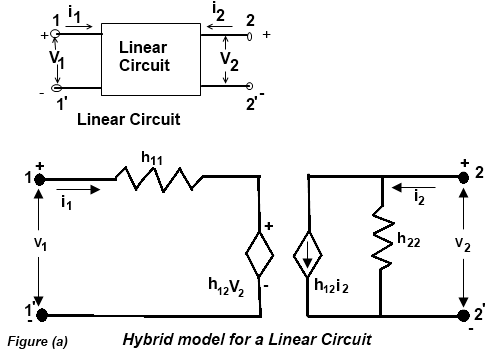Hybrid Parameters
The hybrid parameters are generally used to determine amplifier characteristic parameters such as voltage gain, input and output resistance etc. we have already known that amplifier characteristic parameters may be determined by using current gain(β) and values of other circuit components. Hybrid methods had the following advantages:
- Value of circuit components are easily available, and
- The procedure followed is quite simple and easy to understand.
H-PARAMETERS OF LINEAR CIRCUIT
Every linear circuit having input and output can be analyzed as two port networks. In these networks there are four parameters called hybrid or h-parameters. Out of these four parameters, one is measured in ohm, one in mho and other two are dimension less. Since these parameters have mixed dimension, so they are called hybrid parameters.
Consider a linear circuit shown in Figure (a). in this circuit when input voltage 1 is applied, input current i1 flows. Then output voltage V2 and current i2 appears. Both currents i1 and i2 are assumed to flow inside the box of the linear circuit. Both voltages V1 and V2 are assumed to be positive from the upper to lower terminals.

The linear circuit may be replaced by an equivalent circuit as shown in Figure (a). the equivalent circuit is called hybrid model of a linear circuit. In such as circuit, the input and the output voltages and currents (called variables) may be related by the set of the following two equations:
V1 = h11.i1 + h12.V2
I2 = h21.i + h22.V2
Where
V1 = input voltage
V2 = Output voltage
I1 = input current
I2 = output current
And h11, h12, h21 and h22 are hybrid parameters.
DETERMINATION OF H-PARAMETERS
The parameters h11 and h21 may be determined by short circuiting the output terminals of a given circuit. On the other hand, h12 and h22 may be determined by open circuiting the input terminals of the given circuit.

Determination of h11 and h21
These are determined by short circuiting the output terminals of a given circuit as shown in Figure (b). a shot circuit at the output terminal makes the voltage v2 equal to zero. Input voltage is given by relation,
VI = h11.i1 + h12.V2
Putting the value of V2 (equal to zero) in the above equation, the input voltage,
V1 = h11.i1 or h11=V1/i1
Thus h11 may be determined from the ratio V1/i1. The value of i1 obtained by applying a voltage at the input and then measuring the value of input current (i1). Since h11 is the ratio of voltage to current, therefore it has the units of ohms i.e. the same unit as that of a resistance. Because of this fact, h11 is called input resistance of the circuit with output short circuited. Similarly, output current is given by the relation.
I2 = h21.i1 + h22.V2
Again putting the value of V2 the output current,
I2 = h21. i1 or h21 = i2/i1
Thus h21 may be determined from the ratio i2/i1, the values of i2 and i1 may be obtained by applying a voltage at the input and then measuring the input current (i1) and output current (i2). Since h21 is the ratio of currents, therefore it has no units. The parameter h21 is called the forward current gain of the circuit with output short circuited.
Determination of h12 and h22
These are determined by open circuiting the input terminals of the given circuit as shown in Figure (b). an open circuit at the input terminals, makes the current (i1) equal to zero. We also know that the input voltage is given by the relation.
V1 = h11.i1 + h12.V2
Putting the value of i1 in this equation, the output voltage will be
V1 = h12. V2 or h12 = V1/V2
Thus h12 may be determined from the ratio V1/V2. The value of V1 may be obtained by applying a voltage (V2) and the measuring the input voltage (V1). Since, h12 is a ratio of voltages, therefore it has no units. As h12 is the ratio of input voltage (V1) to the output voltage (V2), therefore, its value known as the reverse voltage gain.
Similarly, the output current is given by the relation.
I2 = h21.i1 + h22.V2
Again putting the value of i1 (equal to zero) in this equation. The output currents will be,
I2 = h22. V2 or h22 = i2/V2
No. | Parameter | Meaning | Condition |
|---|---|---|---|
1 | h11 | Input resistance | Output shorted |
2 | h12 | Reverse voltage gain | Input open |
3 | h21 | Forward current gain | Output shorted |
4 | h22 | Output conductance | Input open |
hi = h11 = Input resistance with output shorted,
hr = h12 = Reverse voltage gain with input open,
hf = h21 = Forward current gain with output shorted,
ho = h22 = Output conductance with input open.
The h-parameters of a transistor depend upon the type of the configuration used i.e. common emitter (CE), common collector (CC) or common base (CB). Because of this, each of the four h-parameters carries a second subscript letter e, b or c. the letter ‘e’ is used to represent common emitter; ‘c’ for common collector and ‘b’ for common base configuration.
S.No | General parameter | Transistor configuration | ||
Common emitter | Common base | Common collector | ||
1 | h11 | hie | hib | hie |
2 | h12 | hre | hrb | hre |
3 | h21 | hic | hfb | hfe |
4 | h22 | hoe | hob | hoe |
